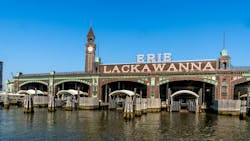NJ Transit issues RFQ/P for anchor tenant of Lackawanna Ferry Terminal
New Jersey Transit (NJ Transit) has advanced the restoration of the 117-year-old Lackawanna Ferry Terminal on the first and second floors of the Hoboken Terminal as part of the broader Hoboken Connect redevelopment project.
The agency has released a request for qualifications/proposals (RFQ/P) for an anchor tenant of the transformed Lackawanna Ferry Terminal. The entity would activate the building, creating a destination to energize the area and provide an amenity for both customers and the Hoboken community while also generating a dependable revenue stream for the agency.
“Through the release of this RFQ/P, we expect to find a partner who shares our grand vision for the possibilities this unique and historic space provides to transform and revitalize the Hoboken Waterfront district,” said NJ Transit President and CEO Kris Kolluri. “We are seeking an operator with the ability to not just manage, but to create a singular destination for top-tier events accessible to people throughout the metropolitan area and beyond.”
Constructed in 1907 and designed by architect Kenneth Murchison in the Beaux-Arts style, NJ Transit notes the building features ornate detailing, grand public spaces and architectural elements reflective of the early 20th century.
Once completed, the agency says the renovated ferry terminal building will feature 35,988 square feet of leasable space on the second floor with an A-3 occupancy classification and a maximum main hall occupancy of 2,084 people. According to NJ Transit, the first floor contains 14,973 square feet of leasable space, also with an A-3 occupancy classification and features a maximum main hall occupancy of 1,032 people.
The multi-phase Hoboken Connect redevelopment project will introduce a mixed-use campus environment, including a 386-unit apartment building, 20% of which will be designated affordable housing, currently under construction, a future Class A office building, reimagined public spaces, including Warrington Plaza and Hudson Place and improved transportation and pedestrian accessibility with a new bus terminal and bike/pedestrian facilities.
